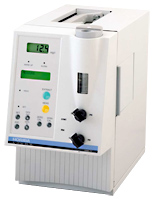
Horiba Quartz Cell Cap for the OCMA-350. The Quartz Cell is designed to allow full light transmission and to be very clear. Quartz is unique in that it doesn’t absorb UV light like some glasses and plastics would. It also doesn’t react with the majority of samples, especially water and oil samples. The OCMA-300 provides swift, highly accurate analysis of the oil content of both fresh water and saltwater as well as that of such fluids as those found at factories and wastewater treatment plants. Compact and simple, HORIBA's OCMA-350 oil content analyzer delivers quick, accurate measurements in the lab or in the field.
- Compact and simple, HORIBA’s OCMA-350 oil content analyzer delivers quick, accurate measurements in the lab or in the field. It efficiently measures the level of oil in water or soil for environmental applications, checks for residual oil on semiconductor parts which have been cleaned, and measures oil on any industrial surface.
- Horiba Quartz Cell for the OCMA-350. The Quartz Cell is designed to allow full light transmission and to be very clear. Quartz is unique in that it doesn’t absorb UV light like some glasses and plastics would. It also doesn’t react with the majority of samples, especially water and oil samples.
Measurement principle: | Solvent extraction, NDIR |
Measurement range: | Water:0 to 200 mg/L, Soil:0 to 1000 mg/kg, Parts:0 to 1 Abs. |
Resolution | mg/L; 0 to 99.9 mg/L; 0.1 mg/L mg/kg; 0 to 9.99 mg/kg; 0.01 mg/kg Abs; 0 to 1000 Abs; 0.001 Abs |
Repeatability | mg/L; 0 to 9.9 mg/L; ±0.4 mg/L ±1 digit Abs; ±1% of full scale |
Measurement | Manually controlled |
Calibration | Automatic calibration after the calibration standard is introduced to the instrument |
Extraction Solvent | S-316 solvent |
Sample/Solvent Volume | Approx. 6.5 mL, ratio of sample to solvent is 1:1 |
Display | Measured value; 3 1/2digits LCD with back-light |
Functions | Self diagnostics, Auto hold function, Calendar clock |
Output | RS-232C and centronics printer port |
Ambient Temperature | 0 to 40 ℃ |
Power | 100 to 240 V AC ±10%,50/60 Hz, 60 VA |
Dimensions | 200 (H) x 250 (W) x 285 (D) mm |
Mass | Approx. 5 kg |
The Horiba OCMA-310 / OCMA-350 Oil Content Analyzers are automated portable units for monitoring oil content in both fresh water and saltwater. The one-touch monitoring process is fully automated, from sample extraction to analysis and sample expulsion. The OCMA-300 utilizes an S-316 extraction solvent to ensure superior oil particle stability and infrared absorptiometry for sample analysis. Using 0mg/l -200mg/l dynamic ranging, the unit is capable of analyzing both high and low concentrations. The OCMA-300 provides swift, highly accurate analysis of the oil content of both fresh water and saltwater as well as that of such fluids as those found at factories and wastewater treatment plants.
Compact and simple, HORIBA's OCMA-350 oil content analyzer delivers quick, accurate measurements in the lab or in the field. It efficiently measures the level of oil in water or soil for environmental applications, checks for residual oil on semiconductor parts which have been cleaned, and measures oil on any industrial surface. Using the OCMA-350 is almost effortless. Simply inject the extract from your sample, dissolved in Horiba's S-316 solvent, into the measuring cell, and press one button. You can even use your PC to simplify operation.


The new OCMA-310 Oil Content Analyzer can assess the amount of trace hydrocarbons in soil or water, as well as check for residual hydrocarbons on pre-cleaned products. The extraction of the oil can be done by Freon 113 and S-316. The S-316 solvent used by the unit may be recycled by HORIBA's optional solvent reclaimer, making the OCMA-310 very environmentally-friendly. Furthermore, the unit's broad measurement range eliminates the need for troublesome range switching. As a result, the OCMA-310 is quick, easy to use, accurate, and reliable.
Horiba Ocma-350 Manual


Recommended Applications
Horiba Ocma-350
- Environment; Surveying water quality and hazardous waste sites
- Industry; Monitoring wastewater influent and effluent
- Marine transportation; Checking bilge and ballast discharge
- Petroleum processing; Monitoring the efficiency of oil/water separation processes
- Oil depots; Monitoring the discharge produced when cleaning storage tanks
- Automotive; Monitoring waste-water discharge from service stations
- Quality Assurance; Measuring residual oil on textiles and metal parts
